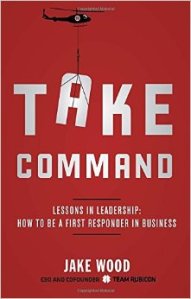 Take Command: Lessons in Leadership: How to Be a First Responder in Business
Take Command: Lessons in Leadership: How to Be a First Responder in BusinessThe books chapters are broken down into the four part process that leaders must take to move forward - prepare, analyze, decide, act.
Take Command
Wood defines a team as, "a group of individual egos, united in pursuit of a common mission or goal, often forgoing personal advancement and comfort for the sake of the whole." (this type of team member is becoming a rare find). But, Wood takes the team up another level, High-Impact Teams (HIT). A high-impact team "is defined by some special internal characteristics along with some environmental ones." A HIT must be faced with a daunting task or high stakes opportunity - a mission with high cost of failure but potential for great reward. Additionally, the team "must be foolish enough to think it can make a change, daring enough to try, and persistent enough to have a chance." These are the ingredients of a HIT - foolishness, daring, persistence. To accomplish great things, and make a great impact, you need to create a high-impact team.
The key component of working as a team is trust. Wood explains that trust, and creating that trust, is composed of the four 'TRs":
Trust = Training + Transparency + Trial & Tribulation
Being an effective team requires competence, open and honest communication, and experience together.
Jake Wood discusses a military term that he applies at Team Rubicon, Commanders' Intent. A Commander's Intent is a form of communicating the mission to the team. It provides critical information by answering the five W's:
Who, What, Where, When, Why
It then identifies the ideal end-state. The expected outcome of the particular mission. The final section defines the conditions and circumstances in which operations will cease.
This document is distributed to all team members a few days before any operation or business move. The application of this document relies heavily on the trust relationship between team members and team leaders. By following the Commander's Intent team members are empowered to improvise or take initiative to accomplish the greater goal.
These are just two of the leadership gems that come from Take Command . This book is a must read for anyone who is a leader (whether by position, or in practice) or desires to lead. As well as, contributing to leadership, the reading of this book can make anyone a better follower.
. This book is a must read for anyone who is a leader (whether by position, or in practice) or desires to lead. As well as, contributing to leadership, the reading of this book can make anyone a better follower.
Take Command opens with this quote:
opens with this quote:
Of every one hundred men in battle, ten should not be there. Eighty are nothing more than sheep. Nine are the real fighters, we are lucky to have them since they make the battle. Ah, but the one - one is the Warrior - and he brings the others home.
- Heraclitus, approximately 500 BC

.jpg)
